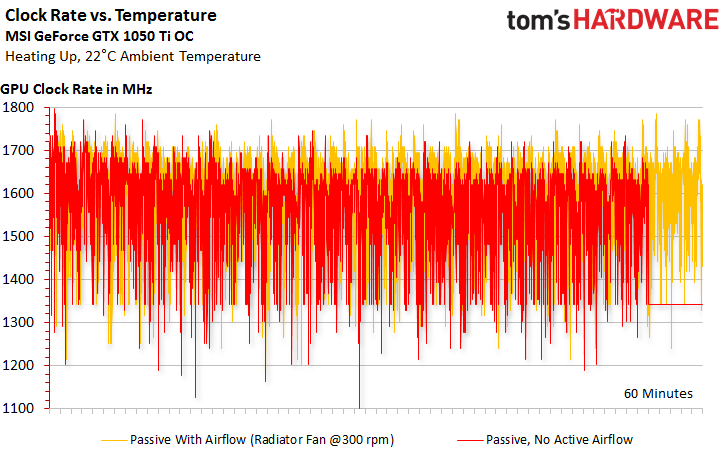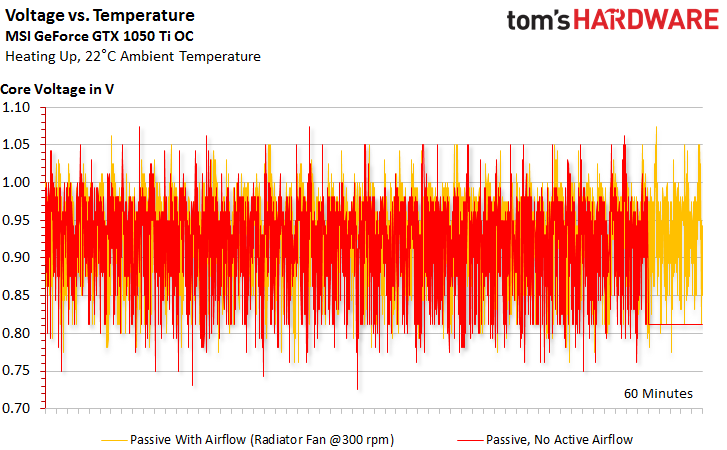Nvidia GeForce GTX 1050 Ti Passive Cooling Mod
Clock Rates, Voltages & Temperatures
Measurements collected in a passively-cooled rig require significantly more test time than in actively-cooled systems. The passively-cooled system can take up to an hour for all of the components inside to reach their final operating temperature. But after 57 minutes, the GPU temperature we recorded drops from our forced limit of 83°C down to 77°C, and then continues to hum along right there. Even after two hours, our measurements show the card posting a constant 77°C, which is astounding.
The original card/cooler combination can function in passive systems with a convincing 63°C result, while the extreme-length cooler in the cavernous workstation with two slow-spinning radiator fans achieves a downright chilly 54°C.
If you're wondering why the passively-cooled, fanless system would suddenly drop in temperature after two hours of running, worry not. We performed more tests to get to the bottom of this.
Our first order of business was recording the GPU frequency, which revealed even more useful information. After running for a while at the factory temperature limit of 83°C, GPU Boost was no longer working to push clock rates higher. The processor leveled off at 342 MHz and stayed there.
The same symptoms are observable in the voltage, which switches to a constant 0.812V. This value, similar to the static clock rate, appears to be some type of fail-safe. Power consumption even drops under 40W. Does this emergency response affect gaming performance, though?
FurMark exposes similar results, though the various limits for power consumption and temperature are reached significantly earlier due to that utility's intensive load. Fortunately, the passively-cooled GPU runs smoothly at maximum load without ever approaching dangerous temperatures.
There's a downside, of course. Cooling a GPU passively and maintaining reasonable temperatures necessitates dialing back clock rates, and ultimately, performance. We certainly don't want to circumvent the safeguards that limit frequency, voltage, and power consumption. They're in place for a reason, and working around them is a recipe for damaged hardware.
Get Tom's Hardware's best news and in-depth reviews, straight to your inbox.
SummaryOur modified cooling solution provides better results than the original, even with limited airflow.A completely passive configuration is entirely possible, though it creates performance limitations.Clock rate and voltage are automatically lowered to protect the card.
Current page: Clock Rates, Voltages & Temperatures
Prev Page The Right Case & Placement Next Page Push it to the Limit!
Igor Wallossek wrote a wide variety of hardware articles for Tom's Hardware, with a strong focus on technical analysis and in-depth reviews. His contributions have spanned a broad spectrum of PC components, including GPUs, CPUs, workstations, and PC builds. His insightful articles provide readers with detailed knowledge to make informed decisions in the ever-evolving tech landscape
-
AndrewJacksonZA Thank you for the really nice article Igor. It was an unexpected surprise and a pleasure to read. :-) Very interesting to read.Reply -
Poozle you know setting the fans to even minimal (20-30%) where you cant detect an audible difference would be safer and nearly as quiet... but I digressReply -
FormatC The problem is, that the marketing is telling us that it works. I ordered an original passive card directly from a manufacturer and will check it in a short follow-up. Without any airflow in the case this must fail ;)Reply -
AndrewJacksonZA Reply
It immediately reminded me of Sapphire's R9 Fury Tri-X:19136703 said:That giant cooler is so funny looking on that little card. :)
-
FormatC Same principle, but the used cooler is 4 years old.Reply
It seems that Sapphire copied the idea ;) -
thor220 It looks like the large tail of that Cooler isn't even doing anything. No point in making a passive cooler that big if it can't transfer the heat.Reply
I would much rather see a passive water cooled setup with no fans, only the pump. -
TJ Hooker Reply
What makes you say that? The heat pipes extend the length of the cooler, even the fins at the end should be absorbing and dissipating some of the heat.19139141 said:It looks like the large tail of that Cooler isn't even doing anything. No point in making a passive cooler that big if it can't transfer the heat.


